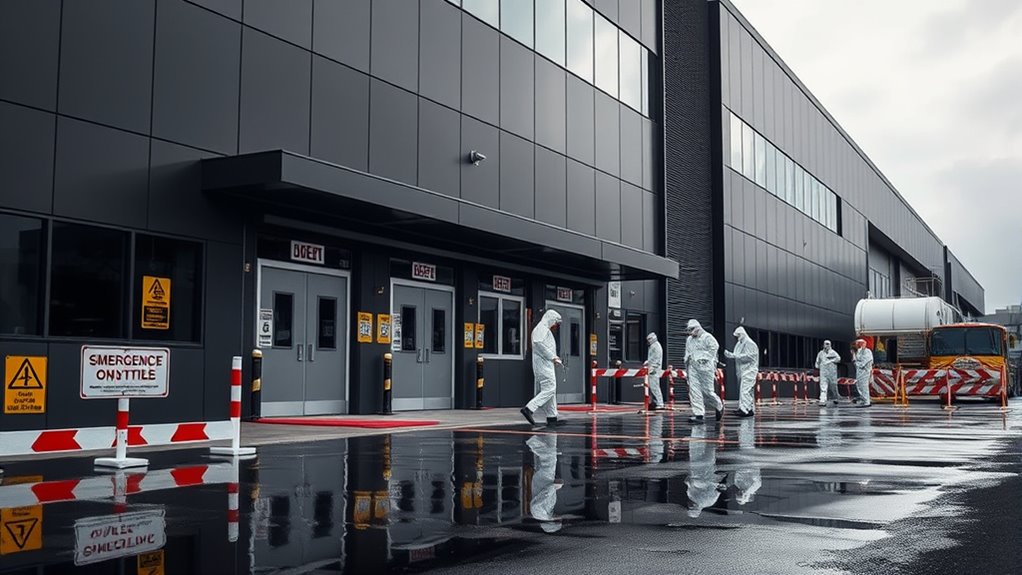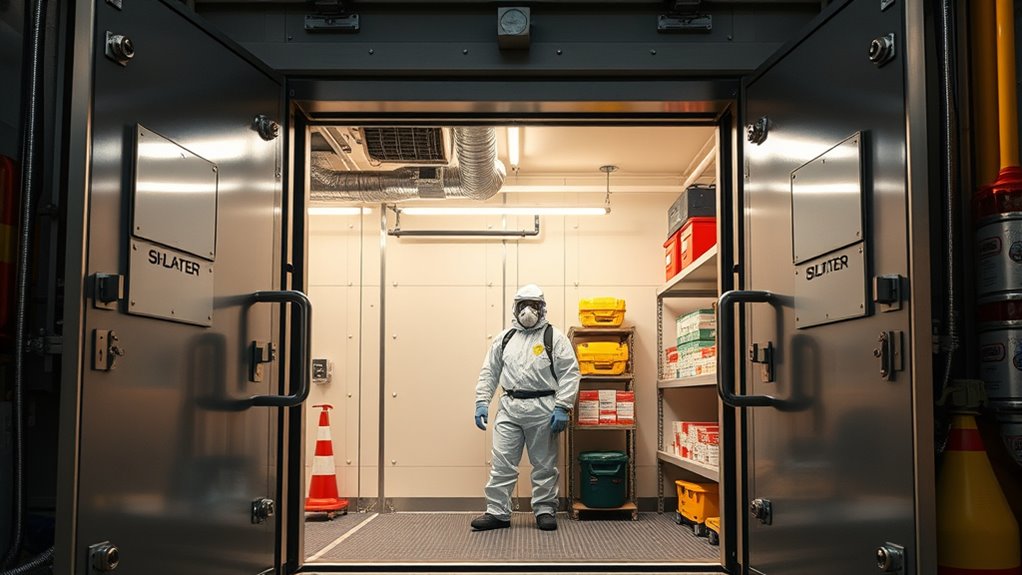In a chemical spill or hazard, your best move is to shelter-in-place immediately. Move to an interior room away from windows and exterior walls. Seal gaps around doors and windows using plastic sheeting, tape, or towels. Turn off ventilation systems and close filters to prevent contaminated air from circulating. Stay calm, listen for official instructions, and wait until authorities say it’s safe to leave. Learning more about these steps can help you stay prepared and protected.
Key Takeaways
- Move to an interior room away from windows and exterior walls immediately.
- Seal all entry points with plastic sheeting, tape, or damp towels to prevent contaminant entry.
- Turn off ventilation systems and close filters to block airborne hazardous substances.
- Listen for official instructions on whether to stay sheltered or evacuate.
- Conduct regular drills to ensure quick, effective shelter-in-place responses during chemical incidents.

When a chemical spill or hazard occurs, sheltering in place can be the safest and quickest way to protect yourself from exposure. Acting swiftly is essential, and understanding your facility’s evacuation procedures is fundamental, even if sheltering in place becomes the primary response. Familiarize yourself with these procedures beforehand so you know what steps to take without hesitation. Typically, this involves moving to an interior room, sealing windows and doors, and turning off ventilation systems to prevent contaminant ingress. Your ability to follow these steps quickly can notably reduce your risk of inhaling or coming into contact with hazardous substances. Additionally, understanding the principles of water chemistry and containment can help you better assess and respond to chemical hazards in your environment. Effective shelter-in-place relies heavily on good communication planning. You need clear, reliable communication channels to stay informed about the hazard’s severity and any updates from authorities or safety teams. Make sure you know how to access emergency alerts, whether through alarm systems, text messages, or designated alert apps. Keep your phone charged and within reach at all times during a crisis. It’s also wise to have a pre-arranged communication plan with family members, coworkers, or neighbors, so everyone understands their role and knows how to coordinate during an emergency. This planning guarantees that you won’t be left in the dark, and it helps prevent misinformation or confusion that could jeopardize safety. When an incident occurs, immediately listen for official instructions. Authorities may broadcast specific guidance, such as whether to evacuate or stay sheltered. If sheltering in place is advised, follow the established procedures carefully. If your workplace or home has a designated safe room, go there promptly. Seal all gaps around doors and windows with available materials—wet towels, plastic sheeting, or tape—to prevent air exchange. Turn off ventilation systems and close any filters that could draw contaminated air inside. Once in your safe space, stay calm, and keep listening to your communication channels for updates. Do not attempt to leave your shelter until authorities declare it safe. Having practiced your shelter-in-place plan is essential. Regular drills help you become familiar with the steps and reduce panic during an actual incident. Your preparedness, combined with solid communication planning and knowledge of evacuation procedures, makes all the difference in safeguarding your health and safety during chemical spills or hazards. Staying informed, acting quickly, and following established protocols ensure you’re doing everything possible to protect yourself and those around you when seconds count.
Frequently Asked Questions
How Can I Identify Chemical Hazards in My Neighborhood?
You can identify chemical hazards in your neighborhood by paying attention to chemical signage at industrial sites, storage facilities, or transportation routes. Stay alert during neighborhood monitoring efforts, such as community meetings or alerts from local authorities. Check for warning signs, labels, or notices about hazardous materials nearby. Being aware of these signs helps you recognize potential risks and take appropriate shelter-in-place measures if needed.
What Are the Long-Term Health Effects of Chemical Exposure?
Chemical exposure can lead to chronic health impacts like respiratory issues, neurological problems, or increased cancer risks. These effects may not appear immediately but develop over time. You should undergo long-term monitoring to catch any health changes early and seek medical advice if you notice symptoms. Staying informed about potential hazards and regular check-ups helps manage and mitigate the long-term health effects of chemical exposure.
How Often Should I Update My Emergency Shelter Kit?
You should update your emergency shelter kit at least every six months. Regular kit maintenance makes certain you have fresh supplies, medications, and updated documents. Check expiration dates on food, water, and medical items, replacing anything outdated. Consider seasonal changes, like adding extra blankets or sun protection. Keeping your kit current makes sure you’re prepared for unexpected chemical spills or hazards, giving you peace of mind when it matters most.
Can Pets Be Safely Sheltered During a Chemical Spill?
Yes, pets can be safely sheltered during a chemical spill if you follow proper shelter procedures. Keep your pets indoors, away from windows and vents, and prepare a designated area with their essentials like food, water, and bedding. Guarantee their safety by keeping them calm and monitoring their condition. By adhering to shelter procedures, you protect your pets from exposure and ensure their well-being during the emergency.
What Community Resources Are Available for Chemical Hazard Alerts?
When it comes to chemical hazard alerts, you need to stay ahead of the curve. Your best bet is to rely on community alert systems and local hazard notifications, which provide real-time updates directly to your phone or community boards. Sign up for local emergency alerts, check government websites regularly, and stay connected through social media channels. This way, you’re not caught off guard when danger strikes, and you can act swiftly to protect yourself and loved ones.
Conclusion
Remember, acting quickly can save lives during chemical spills. Studies show that sheltering in place can reduce exposure by up to 90%, making it the safest choice in many emergencies. Stay calm, follow your plan, and listen for official instructions. By knowing these strategies, you’re better prepared to protect yourself and others. Don’t wait—your swift action could be the difference between safety and harm in a chemical hazard situation.









